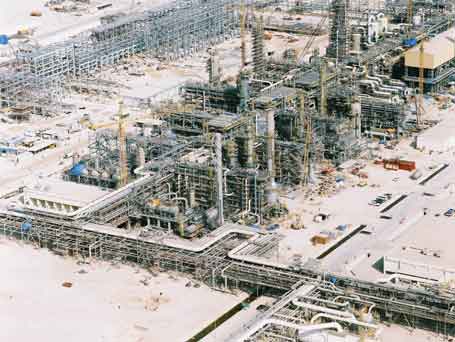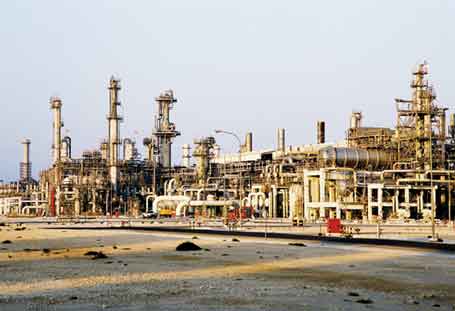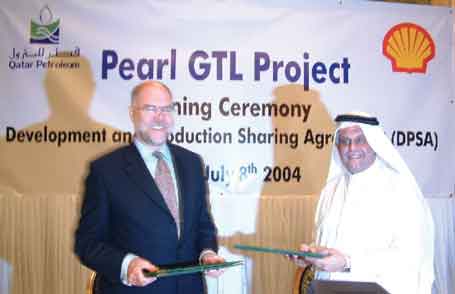Qatar investing in incremental Energy Projects
A Background of Qatar's O & G sector and its plans for the future.

LNG Train 3 for RasGas (II)
Qatar has proven, recoverable oil reserves of 15.2 billion barrels. The onshore Dukhan field, located along the west coast of the peninsula, is Qatar’s largest producing oilfield. Qatar also has six offshore fields, Bul Hanine, Mydan Mahzam, Id al-Sharqi North Dome, al-Shaheen, al-Rayyan, and al-Khalij.
Qatari crude oil has gravities in the 24 degrees-41 degrees API range. The country’s two primary export streams are Dukhan (41 degrees API) and Marine (36 degrees API) blend. Despite the country’s significant oil production and reserves, oil accounts for less than 15 per cent of domestic energy consumption.
Qatar works hard to maintain its daily output capacity of 850,000 barrels of crude oil while work is in progress on the North Gas Field development project, which is scheduled to be completed in 2010 and is estimated to produce more than 18 billion cubic feet of liquefied natural gas (LNG) per day.
The Qatari leadership also seeks to increase the output capacity of LNG to more than 60 million tonnes per year from the current level of about 14 million tonnes per year.
Apart from the four trains of gas liquids operating at present in Mesaieed, the future development projects of the North Gas field will base their LNG plants in Ras Laffan Industrial City.
Production and Exports
In 2003, Qatar’s average output of crude oil was 750,000 barrels per day, of which about 40 per cent was produced from the onshore fields, 60 per cent from the offshore fields; 601,000 barrels are the property of the state. The average exported amount of crude oil and oil products reached 574,000 barrels per year.
The main productive oil and gas fields include:
Onshore Operations
Dukhan Oil Field
Exploration for oil in the Dukhan area started in 1935; Dukhan field was the first to be discovered with commercial quantity of oil when the first oil well was dug between 1939 and 1940. This field is 65 km long and 5 km wide.
Dukhan comprises three crude oil reservoirs and one non-associated gas reservoir. Production started at Dukhan field in 1947 and the first shipment of its oil was exported in December 1949.
The output capacity of crude oil at Dukhan field amounts to 335,000 barrels per day, while the production installations of associated and non-associated gas, natural gas liquids and condensates are based in Arab D Block. In 1998, work started to recycle Arab D Block gas by processing 800 million cubic feet of gas per day to produce 36,000 barrels of stable condensate.
Offshore Operations
Offshore oil fields play a vital role in the development of the oil sector in the State of Qatar. The two offshore fields oprated by QP are Mydan Mahzam and Bul Hanine. Other fields such as Al Shaheen, Al Rayyan, Al Khaleej, Idd Al Sharqi and Al Karkara are operated according to exploration and development sharing agreements (DPSA) with a number of major international oil firms.
According to these agreements, the companies invest in the development and share the production with the State. QP produces crude oil, associated gas and condensate from the two fields of Mydan Mahzam and Bul Hanine, which are located off Qatari territorial waters. In 2003, the reserves at these fields were estimated to be about 579.6 million barrels of crude oil, 197 million barrels of condensate and 3.94 trillion cubic feet of gas.
Idd Al Sharqi
Discovered in 1960, this field was the first offshore field and the second generally to be discovered in Qatari territorial waters. It lies 80 to 85 kilometers off the East Coast of Qatar and started production in 1964.
Production level in 2003 came close to 86,000 barrels a day at Idd Al Sharqi North Dome and 10 thousand barrels a day at Idd Al Sharqi South Dome.
Oxy, QP award CGG 3D project
CGG was recently selected to process two leading-edge multi-component (3D/4C) OBC surveys for Occidental Petroleum of Qatar and Qatar Petroleum over the Idd Al Sharqi field in Qatar.
The Idd Al Sharqi field consists of two highly fractured carbonate reservoirs, which have been in production for decades. The field has been targeted for a multi-component seismic study, due to the need to enhance understanding of the reservoir and fracture network for further development planning.
The two studies, which cover both the North and South areas of the field, are designed exclusively for multi-component and wide-azimuth acquisition. CGG was selected in competitive bidding, for its azimuth-friendly algorithms to improve the information that can be retained from the amplitude variations with azimuth. The VectorVista suite of tools will be used in the processing of both the PP (conventional) and PS (converted wave) data to optimize results of the converted wave processing. This, coupled with CGG's A+ suite of software for anisotropy, is expected to provide data that will significantly improve Occidental's understanding of the highly complex fracture network at Idd Al Sharqi.
Once processed, further work will be conducted on the data by the Oxy and Qatar Petroleum teams — combining both PP and PS fracture and anisotropy related attributes in order to complete the characterization study and enhance the overall understanding of the reservoir.
Acquisition of the surveys started in December 2003 and was completed in May 2004. The processing sequence is anticipated to take between 12 and 12.5 months after CGG received the final field tapes and is expected to yield new insights into the characteristics of the reservoir and aid in future development work.
Mydan Mahzam
Discovered in 1936, this field covers an area of about 30 square kilometers. In 2003, its average production of oil reached 38,800 barrels per day.
Bul Hanine
Discovered in 1965, this field belongs to Qatar since 1969 as a result of marine border delineation and distribution of border islands between Qatar and Abu Dhabi. It is one of the largest offshore fields, covering about 80 square kilometers, with a production capacity of about 67,800 barrels per day.
Al Bandaq
Discovered in 1964, this field covers 20 square km. It strides the marine borderline between Qatar and Abu Dhabi and its production is divided between the two countries.
Al Shaheen
This field was discovered by Maersk in 1992, and it has reserves of about 780 million barrels of oil, according to 2003 estimates. Production started in this field in 1994 with an average daily capacity of 30,000 barrels a day. In 2003 production jumped to 182,000 barrels a day.
Al Rayyan
This field was initially operated by Wintershall Consortium with Arco and then BP as operator before Anadarko finally took over operation in 2002.
In 2003 its daily output capacity fell to 12,000 barrels from the production level of the previous year due to a three-month closure to install a new permanent production unit.
According to its development plan, the field is expected to witness a period of stability, during which its output capacity is expected to jump to 25,000 barrels per day.
Al Khaleej
This field was discovered by the French company Elf Aquitaine in 1991. It has about 334 million barrels in reserves according to the statistics of 2003.
In 1997, the daily production capacity at this field was about 10,000 barrels, compared to + 34,000 barrels registered in 2000.

QatarGas plant
Al Karkara and A Structure
These structures were discovered in the 1970s, but they were not commercially significant at that time. In July 1997, an exploration and development sharing agreement was concluded with the Japanese consortium Qatar Petroleum Development (QPD), who presented a comprehensive development plan of the field in 2003, which QP endorsed. In January 2003, the reserves of the field were estimated to stand at about 42.6 million barrels.
Qatargas
Established in 1994 and commissioned in 1997, Qatargas is a joint venture of QP, Total, Exxon Mobil and Japanese Mitui and Marubeni. It presently produces about 8 million tonnes of liquefied natural gas (LNG) from three trains; and its plant processes 60 thousand barrels per day of condensate in addition to sulphur. Output capacity of the plant is expected to rise to 9.2 million tonnes annually when the on-going project to upgrade the current facilities is completed in 2005. Qatargas operates purpose-built ten
LNG vessels, each with a capacity of 135 thousand cubic meters.
In 2010 Qatargas is expected to double its annual LNG output capacity by adding new trains, which will be the largest of their kind in the field. Other projects including a refinery for condensate, a power plant, a helium plant and an aluminum smelter are planned for Ras Laffan Industrial City.
RasGas
Established in 1993 and commissioned in 1999, Rasgas is a joint venture of Qatar Petroleum (QP), America’s Exxon Mobil, Korean company Kogas and the Japanese companies LNG Japan and Itochu.
The company produces liquefied natural gas (LNG) from a two-train plant with an annual output capacity of 6.6 million tonnes of LNG and a daily output capacity of 45 thousand barrels of condensate.
Sheikh Hamad Bin Khalifa al Thani the Emir of the State of Qatar inaugurated the third train in Ras Laffan Industrial City in March 2004 with an annual output capacity of 4.7 million tonnes of LNG. This train, owned by RasGas II, is considered to be one of the largest of its kind in the world and a landmark milestone in QP’s history. The production of the third train will be exported to India through an agreement with Petronet. Train 4 is under construction and when completed will lead to total production by RasGas of 16 mta.
Train 3 sources feed gas from Block B of the North Field, which is immediately east of the Block A concession. The Train’s offshore facilities are located around 17 kilometers from Trains 1 and 2 facilities and include a remote wellhead platform and a new pipeline to shore.
Seven wells supply the gas required by Train 3. The nine-slot wellhead platform is capable of producing 800 million standard cubic feet a day (mmscfd) of feed gas which is transmitted to the onshore facilities via the new 99 kilometre-long 38 inch three-phase pipeline which has a nominal capacity of 2000 mmscfd. Excess capacity was designed into the pipeline for future expansion projects.
The new wellhead platform’s operation will be monitored by personnel located at the existing Train 1 and 2 offshore complex. Other cost synergies include the use of a portion of the excess capacity from turbine generators on the existing process utilities platform to supply electrical power and communications to the new platform through a sub-sea combined power and data fibre optic cable. Again, foresight was applied in Train 1 and 2 design to allow achievement of these synergies for use in Train 3 and other future Trains.

Energy Minister Al-Attiyah and Malcolm Brinded of Shell, sign the Pearl GTl Project DPSA
“One major difference with Train 3 is the switch from a dry gas to a wet gas pipeline strategy. In addition to cost savings, the use of a wet gas pipeline also allowed a significant increase in the capacity of the pipeline through elimination of the offshore dehydration equipment and its associated pressure drop,” Paul Jones, RasGas Venture Manager, told Pipeline Magazine.
The thicker 38-inch wet gas pipeline, he said, allows full wellstream fluids to be brought to shore without expensive offshore dehydration facilities. And a total throughput increase of 25 per cent to 2 BSCFD gas equivalent reduces unit costs for transporting gas to shore for processing.
GTL Projects
Earlier this year, Qatar Shell GTL Limited announced the spudding of the first appraisal well in the giant North Field for the $5 billion, 140 kbbl/d integrated gas-to-liquids project. The appraisal drilling campaign will comprise drilling of two wells in the North Field.
The wells will determine the reservoir properties and structure as well as validate the composition of the gas in the area of the North Field provisionally allocated to the project.
QP and Qatar Shell GTL Limited (Shell), a company of the Royal Dutch/Shell Group, in July 2004 signed an integrated Development and Production Sharing Agreement (DPSA) that provides for the fiscal and legal terms for the Pearl GTL project. ‘Pearl GTL’ is the name given to the project announced by QP and Shell last October at a Heads of Agreement signing in Doha. The agreement reaffirms Shell’s long-term commitment to Qatar and confirms the company as a leader in GTL development.
The Government of the State of Qatar and an Exxon Mobil Corporation subsidiary, ExxonMobil Qatar GTL Limited, in the same month entered into a Heads of Agreement (HOA) for an approximately $7 billion, Gas-to-Liquid (GTL) project, which would be the world’s largest single, fully integrated GTL project
Inputs from EIA & Ministry of Foreign Affairs, Qatar |



